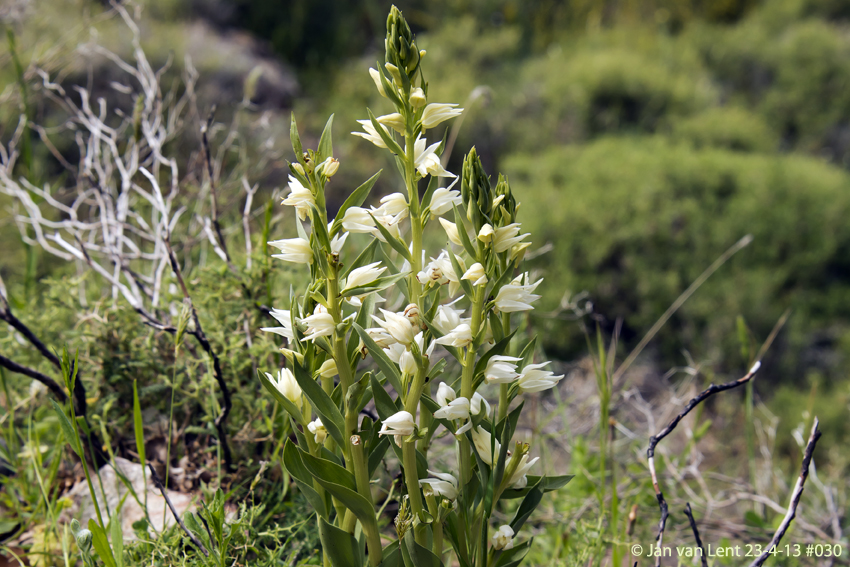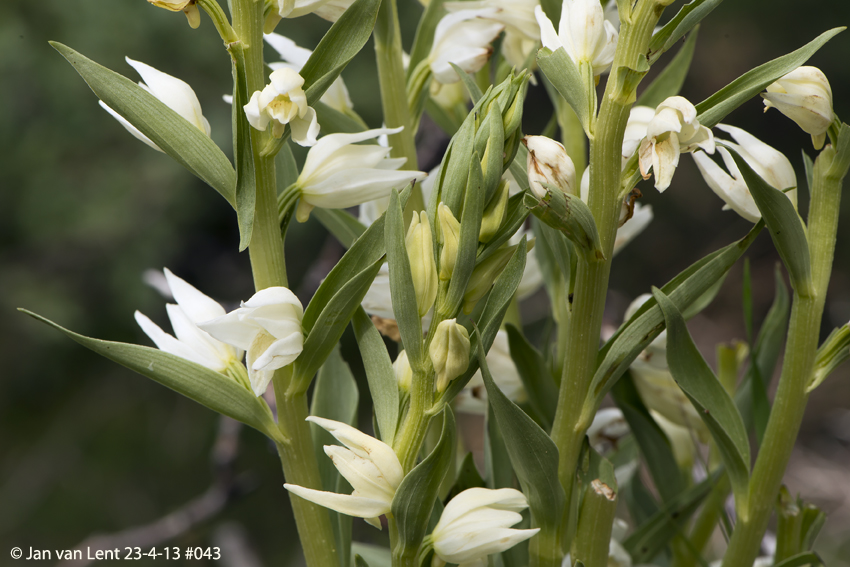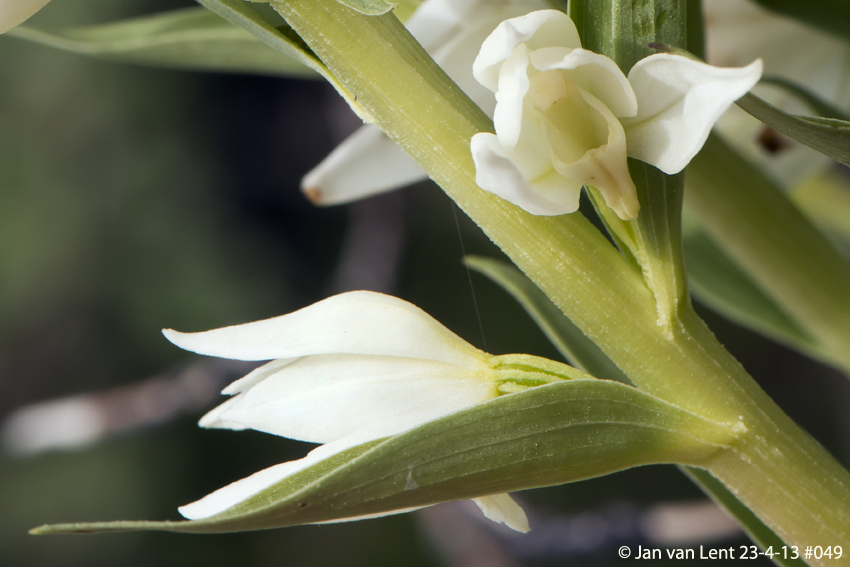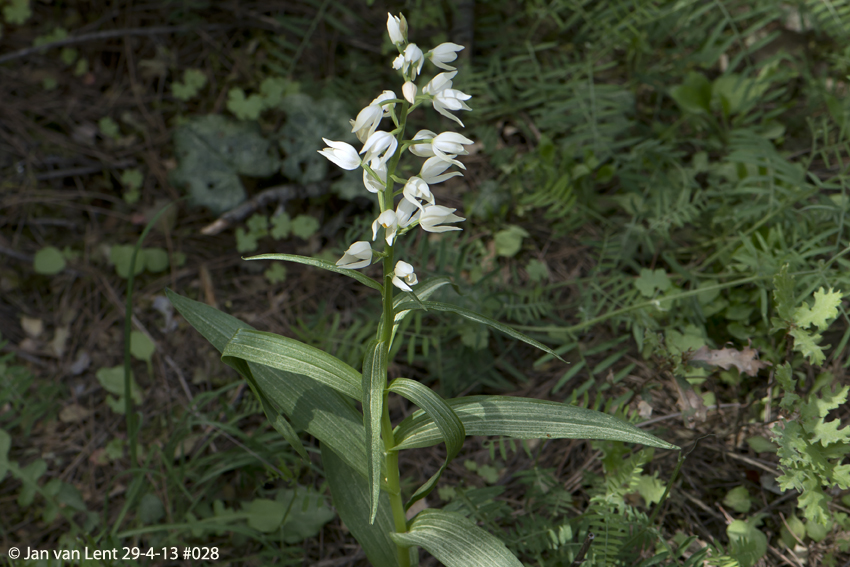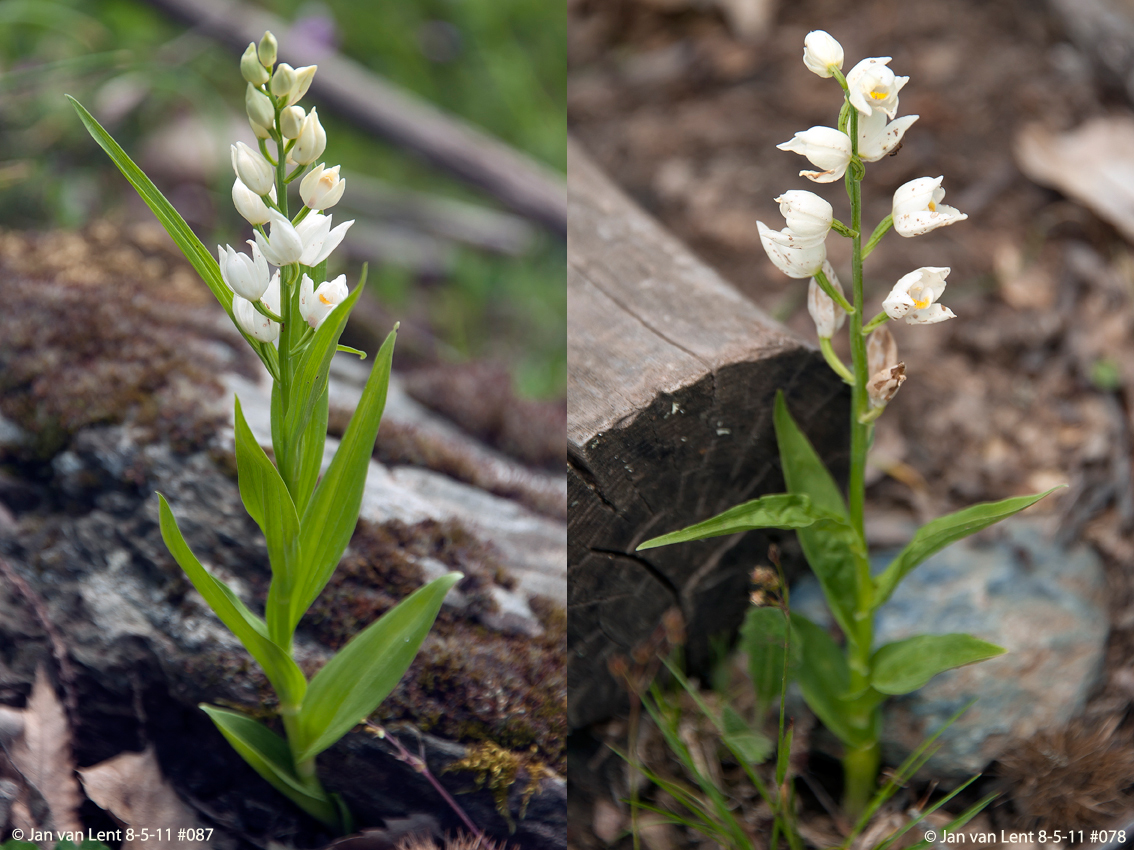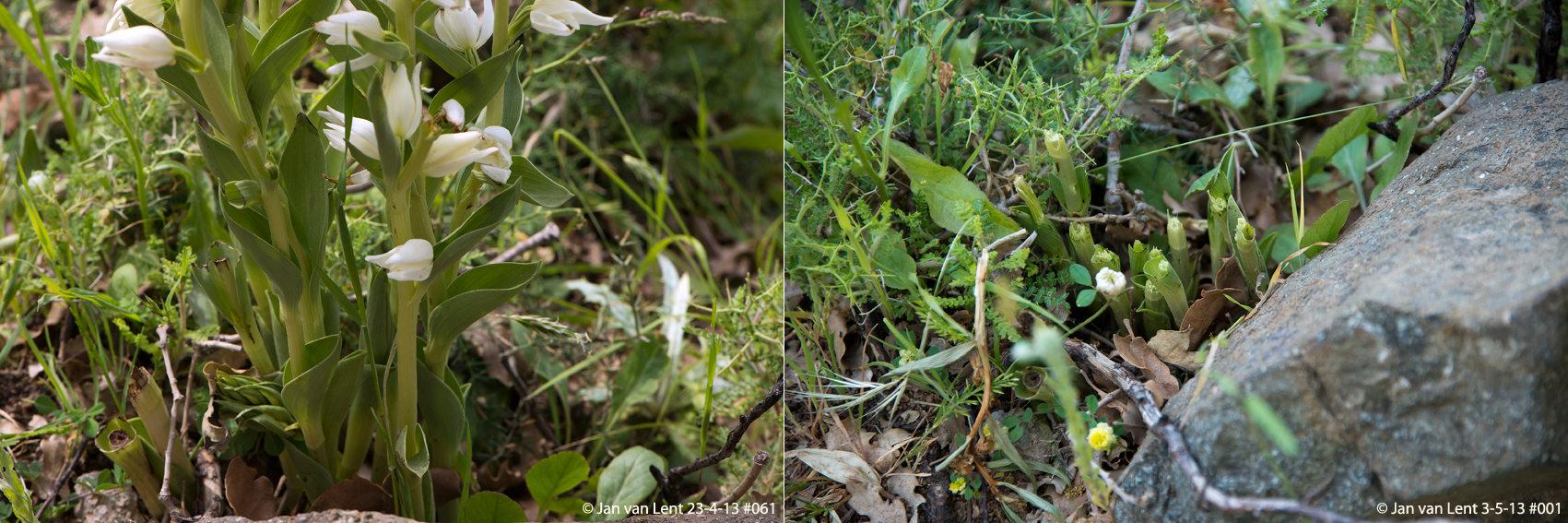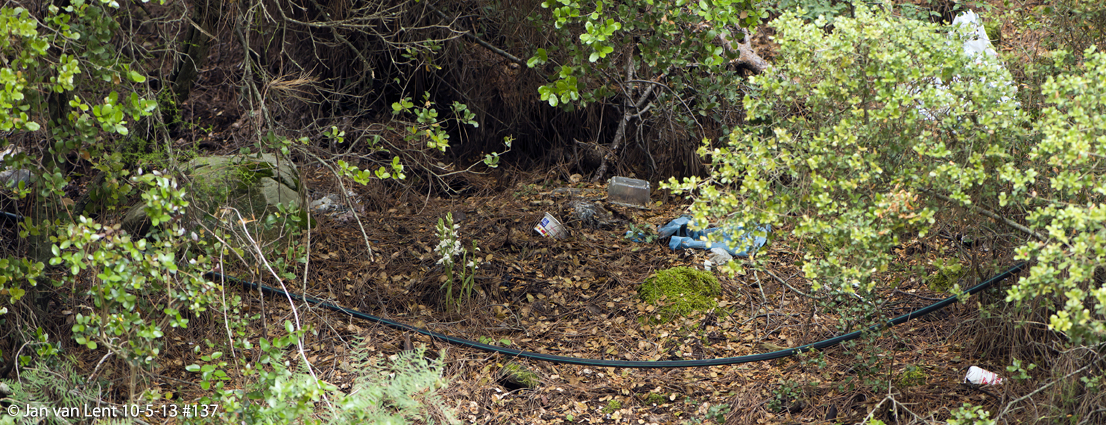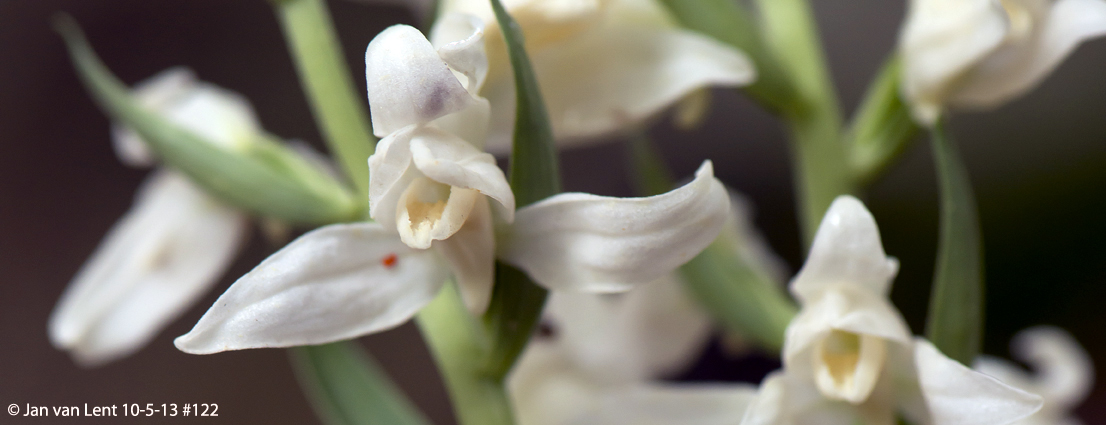Habitat: Eftalou & Agiasos.
Cephalanthera epipactoides, Eftalou, © Jan van Lent 23-4-13 #063.
Cephalanthera epipactoides Fisher & Meyer 1854.
Cephalanthera longifolia (L.) Fritsch 1753.
The genus Cephalanthera L.C. Richard 1818,
on Lesvos: C.epipactoides, C.longifolia, maybe C.damasionum and C.rubra.
Cephalanthera epipactoides, Eftalou, © Jan van Lent 23-4-13 #030.
REMARKS: The last blog I started with the sentence that ‘it was not so long ago that Ophrys iricolor was hunted down for the first time on Lesvos; it was in 1978 and P.PEISL and H.R. REINHARD were the hunters’. Now I have to start with: It is already very long ago that Cephalanthera longifolia was spotted for the first time on Lesvos. It was in 1897 by the French explorer P.C. CANDARGY under the name C.ensifolia. Cephalanthera epipactoides had to wait almost 70 years (until 1969) before E. STAMADIADOU discovered the plant on Lesvos. And then, in 1995, G. BLAICH described a C.longifolia variation under the name Cephalanthera longifolia var. chlorotica.
Cephalanthera epipactoides, Eftalou, © Jan van Lent 23-4-13 #043.
HUNTING: You don’t have to hunt the Long- or Sword-leaved cephalanthera on Lesvos; if for instance you walk the path from Agiasos up to Olymbos in May you almost stumble over them. And also in the Chestnut forest you can’t miss those white flowers with the long leaves in front of all the green. C.epipactoides is another story. I have been hunting almost 5 years for this taxon (like I still do for C.damasionum and C.rubra: still didn’t find them) behind the airfield of Mytilini but it never appeared. And if I look in the ‘Big Biel’* I only see a hamlet and a small fishing harbour with the name Kratigos appearing as the habitat of C.epipactoides. The last time anyone saw it ‘live’ was B. Biel on 16.05.1996: ‘70m W border Kratigos (=?Agrilia Kratigou), steep mountain slope in light Pine forest and Olive tree border: Anacamptis pyramidalis, Cephalanthera epipactoides, Cephalanthera epipactoides var. chlorotica, Ophrys mammosa.’
Until last week; in Eftalou.
And not in a (light) Pine forest but on a cliff in the middle of the phrygana up from the beach with almost the same view of Turkey as I have when I walk to my beach, so at a distant of 2km from my house. The plants were discovered by Leon Boogaart and Anke Sinnema, who came for the first time to Greece, for the first time to Lesvos, on their first day and on their first walk. And there it was: Cephalanthera epipactoides. Yep. And they thought that it was quite normal to find a Helleborine-like cephalanthera in Eftalou, that is, until they met me the next day for a 3 day orchid hunt…
Cephalanthera epipactoides, Eftalou, © Jan van Lent 23-4-13 #049
RESEARCH: In SUNDERMANN (Europäische und mediterrane Orchideen, 1980) I didn’t find an orchid with the name Cephalanthera epipactoides, but I found Cephalanthera cucullata ssp. epipactoides, actually the same plant if you look at the photographs and read SUNDERMANN’s descriptions: ’25-100cm, lower leaves bag shaped, the higher ones often flat and sticking out; the stem is often already from the lower fifth filled with up to 40 flowers; flowers white; spur 3-5mm long.
Habitats: ‘Eastern Aegean islands, Turkey (from the Galipoli peninsula eastwards approx. to the Mersin province in the South, in the North to Artvin.)’ He has 3 more subspecies of C. cucullata: ssp. cucullata (only in the Ida mountain on Crete); ssp. kurdica (in the east of Turkey, the north of Syria and Persia) and ssp. floribunda (east Pontus, Kaukasus). And of course he described C.longifolia (no subspecies here), C.rubra and C.damasionum with ssp. caucasica and kotschyana.
Cephalanthera longifolia, Agiasos, Chestnut forest © Jan van Lent 29-4-13 #028
Twenty-five years later nothing changed much, only ssp. floribunda left the scene.
DELFORGE (2005) now described the remaining 8 Cephalanthera as species, not as subspecies anymore, for Europe, North Africa and the Middle East: C.kotschyana (eastern Anatolia, Azerbaijan), C.caucasica (South-eastern Caucasus and North Iran); C.damasionum (Europe and Asia in the temperate and sub-Mediterranean zones); C.longifolia (Europe and Asia in the temperate and sub-Mediterranean zones, from the Atlantic to the Himalayas, northwest to Trondheim in Norway); C.rubra (Europe and Asia in the temperate and sub-Mediterranean zones, from the Atlantic to the Caspian Sea) C.epipactoides (Eastern (sub-) Mediterrean, from northern Greece (Thrace) east to Antalya and Ordu (Anatolia); C. kurdica (the Near East) and C.cucullata (endemic to Crete).
There are 5 Cephalanthera’s flowering in Greece: C.epipactoides, C.longifolia, C.damasionum, C.rubra and C.cucullata. (PETROU, 2011). From these 5 taxa, 4 should been flowering on Lesvos (KARATZÁ, 2008); only C. cucullata is not around because Lesvos is not Crete.
Those 4 Cephalanthera on Lesvos are clearly distinguished from each other;
C.epipactoides has small leaves, broad bracts and a spur on the back of the flower, C.longifolia has long, lanceolate leaves; the upper bracts are very small and it has a yellow blotch on the edge of the lip, no spur.
C.damasionum: bracts longer than the upwards facing flowers, larger flowers, epichile orange inside with yellow ridges; no spur.
C.rubra is pink/red.
So far, so good. But which of those is this Cephalanthera on the right picture then?
Chestnut forest 8-5-2011: #087 Cephalanthera longifolia; #078 Cephalanthera x schulzei or schaberi?
On the 8th of May 2011 I was photographing a group of Cephalanthera in the Chestnut Forest above Agiasos when I saw one Cephalanthera standing behind a tree stump with a lot of brown spots on the, compared with longifolia, bigger flowers. This one also had much shorter leaves and the leaves didn’t have the veins which are so characteristic for C. longifolia and the texture of those leaves was very soft and smooth, not rough like the ones from longifolia. They looked like the ones from Cephalanthera damasionum. But the plant had the typical longifolia inflorescence, so without the long bracts between the flowers. In his book ‘Die Orchideen der Türkei’, KREUTZ (1998) describes a few Cephalanthera longifolia-hybrids: Cephalanthera damasonium x Cephalanthera longifolia = Cephalanthera x schulzei E.G.CAMUS, BERGON & A.CAMUS 1908 and Cephalanthera epipactoides x Cephalanthera longifolia = Cephalanthera x schaberi H.BAUMANN 1980.
KREUTZ: Cephalanthera x schaberi: ’Described from the province Çanakkale on the Gabibolu peninsula (9-5-1980). A specimen was also found (28-4-1988) on a cemetery in the neighbourhood of Yapildak (Çanakkale).’ Well, Çanakkale is opposite Lesvos, so which is this Cephalanthera with the brown spots (#078, #079)?
But I have to go for Cephalanthera x schulzei because those lower leaves look more the same and even with my loupe I can’t see the most finicky spur on the flower…
BOTTOM-LINE: And I should have known when I looked closely at the photographs that some plants had already completely vanished and that a lot of leaves had been nibbled. But I thought that the sheep maybe didn’t like Cephalanthera epipactoides and that they wouldn’t come back. But they did in the next days and finished all Cephalanthera completely, down to the ground. Two days later it was Greek Easter. I ate as much sheep as I could that day but I don’t think it helped to preserve those epipactoides next year.
Cephalanthera epipactoides, Eftalou, 23-4-13 #061 & 3-5-13 #001 © Jan van Lent.
But then I got a message from friends that they found yesterday a bunch of not yet eaten (because they were hidden under a garbage dump) C. epipactoides opposite of the Sanatorio above Agiasos! So here they are, standing in the rain in the immaculate forest …
Cephalanthera epipactoides, Sanatorio, Agiasos, © Jan van Lent 10-5-13 #137
Jan van Lent, Lesvos, 11-5-2013
‘With a little help from my friends’: Joe Cocker, 1968, this version is from 2002.
www.youtube.com/watch?v=_wG6Cgmgn5U
In Memory of Joe Cocker, 1944-2014.
*Big Biel: see ARTICLES.
*Vicariant: allopatric* taxa originating from the same ancestral species.
*Allopatric: species occupying geographic ranges that do not overlap.
*Sympatric: species occurring in the same area or whose ranges overlap.
Cephalanthera epipactoides, Sanatorio, Agiasos, © Jan van Lent 10-5-13 #122


